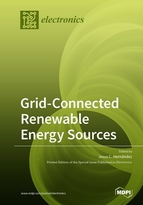Grid-Connected Renewable Energy Sources
A special issue of Electronics (ISSN 2079-9292). This special issue belongs to the section "Power Electronics".
Deadline for manuscript submissions: closed (31 December 2020) | Viewed by 45645
Special Issue Editor
Interests: power electronics; renewable systems; microgrids; electric vehicles; power quality; power systems simulation; metaheuristic optimization
Special Issues, Collections and Topics in MDPI journals
Special Issue Information
Dear Colleagues,
Power generation architecture is rapidly shifting from being centralized to being decentralized. Instead of depending on only one energy source, a wide range of types can now be used. This will eventually lead to the widespread penetration of power electronics based on non-synchronous or renewable power generation. These grid-interactive power converters will significantly enhance the flexibility, controllability, and efficiency of conventional power systems. Smart control strategies can thus enable energy management capabilities as well as the provision of ancillary services to the grid from renewable power. Nevertheless, maintaining a reliable and safe power system poses significant challenges
The main aim of this Special Issue is to seek high-quality contributions that address current issues related to more sustainable, safer, and more resilient power systems. Topics of interest include but are not limited to the following:
- Renewable energy conversion;
- Emerging renewable energy technology;
- Power conditioning devices for the grid integration of renewable energy sources;
- Centralized and distributed energy storage systems for reliable and secure power systems (batteries, supercapacitor, hydrogen, flywheel, pumped hydro storage, etc.);
- Renewable energy policies (market design);
- Power quality problems with renewable energy sources;
- Computations methods for assessing the power grid resilience and safety with renewable energy sources;
- Intermittent renewable energy sources: assessing and control strategies;
- Impact of the increasing demand of electric vehicle charging;
- Energy management systems for grid-connected renewable energy sources;
- The provision of ancillary services to the grid from renewable energy sources;
- Monitoring, prognostic and diagnostic of grid-connected renewable energy sources.
Dr. J. C. Hernandez
Guest Editor
Manuscript Submission Information
Manuscripts should be submitted online at www.mdpi.com by registering and logging in to this website. Once you are registered, click here to go to the submission form. Manuscripts can be submitted until the deadline. All submissions that pass pre-check are peer-reviewed. Accepted papers will be published continuously in the journal (as soon as accepted) and will be listed together on the special issue website. Research articles, review articles as well as short communications are invited. For planned papers, a title and short abstract (about 100 words) can be sent to the Editorial Office for announcement on this website.
Submitted manuscripts should not have been published previously, nor be under consideration for publication elsewhere (except conference proceedings papers). All manuscripts are thoroughly refereed through a single-blind peer-review process. A guide for authors and other relevant information for submission of manuscripts is available on the Instructions for Authors page. Electronics is an international peer-reviewed open access semimonthly journal published by MDPI.
Please visit the Instructions for Authors page before submitting a manuscript. The Article Processing Charge (APC) for publication in this open access journal is 2400 CHF (Swiss Francs). Submitted papers should be well formatted and use good English. Authors may use MDPI's English editing service prior to publication or during author revisions.






